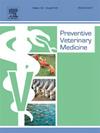关于农场管理者对HPAIV风险的认知和英国家禽农场生物安全措施实施的定性研究
IF 2.2
2区 农林科学
Q1 VETERINARY SCIENCES
引用次数: 0
摘要
高致病性H5N1禽流感(HPAI)在2021年至2023年期间在英国和北欧流行,使以前的所有入侵都相形见绌。这一事实促使有必要审查商业家禽养殖场的生物安全行为和对病毒入侵的看法。本研究采用定性方法评估了农场管理者对生物安全的认识以及他们对动植物卫生局(APHA)建议的措施的实施情况。在2023年5月至9月期间,英格兰和威尔士不同地区的13名农场经理被招募参加了这项研究。与管理人员进行了定性半结构化访谈,讨论与生物安全和禽流感有关的各种主题。还观察了管理人员和工作人员在整个农场使用的生物安全措施,以帮助了解生物安全行为。对访谈进行转录和分析,以确定数据中的主题和模式,以及在农场访问期间整理的大量笔记。调查结果表明,农场在消毒制度方面使用生物安全措施和使用足底浸液都得到了很好的引用和观察。同样,农场管理者都极有可能提到使用特定农场和特定猪舍的胶靴,同时也提到了对访客和交付/维护的更严格要求。许多农场的生物安全涉及场地的布局、围栏、更衣室的进出以及建筑物和棚子的总体年龄和维护,需要进行重大改进。此外,农场管理者近年来表达了强烈的压力和焦虑感,特别是那些最近经历过人工智能疫情的农场管理者。我们认为,风险认知、控制范围、责任感和自主性以及对心理健康的影响等因素都可以告诉农场管理者如何应对疫情,以及如何在农场实施或维持生物安全。更加强调为该行业提供定期和量身定制的培训和教育资源将是有益的,同时也有助于进一步提供侧重于减轻农民心理健康负担的服务。本研究提供了对商业家禽养殖场生物安全实施的应用和不足的见解。它还确定了影响农场实施的农民观念和经验。然而,这突出表明,改善生物安全的责任不能仅仅由农场管理者和工人承担。进一步研究探索行业中其他利益相关者的作用将有助于弥合我们对生物安全实施的理解中的剩余差距。本文章由计算机程序翻译,如有差异,请以英文原文为准。
Qualitative studies on farm managers perception of risk from HPAIV and implementation of biosecurity measures on UK poultry farms
The epidemic of high pathogenicity avian influenza (HPAI) H5N1 in the United Kingdom and Northern Europe from 2021 to 2023 has dwarfed all previous incursions. This fact has driven the need to review biosecurity behaviours and perceptions of virus incursions on commercial poultry farms. This study used qualitative methods to evaluate farm managers’ perceptions of biosecurity and their implementation of measures as recommended by the Animal and Plant Health Agency (APHA). Thirteen farm managers across different regions of England and Wales were recruited between May and September 2023 to take part in the study. Qualitative semi-structured interviews were held with managers to discuss various topics relating to biosecurity and avian influenza (AI). Biosecurity measures being used across the farm by managers and staff were also observed to help understand biosecurity behaviours. Interviews were transcribed and analysed to identify themes and patterns amongst the data, along with extensive notes collated during the farm visits. Findings showed that farms’ use of biosecurity with respect to disinfection regimes and use of foot dips were both well cited and observed. Similarly, farm managers were all highly likely to refer to the use of farm-specific and shed-specific rubber boots, while also citing stricter requirements for visitors and delivery/maintenance. Biosecurity concerning the layout of the premises, fencing, access to changing rooms and the general age and maintenance of buildings and sheds required significant improvement across many farms. Additionally, farm managers expressed strong feelings of stress and anxiety in recent years, particularly those who had experienced an AI outbreak recently. We argue that factors such as risk perceptions, remits of control, feelings of responsibility and autonomy, and consequences on mental health, are all factors that can inform how farm managers respond to outbreaks and implement or sustain biosecurity on farms. A greater emphasis on providing regular and tailored training and educational resources for the industry would be beneficial as would further services focusing on reducing the burden on farmers’ mental health. This research provides insight into the application and shortcomings of biosecurity implementation on commercial poultry farms. It also identifies farmer perceptions and experiences shaping implementation on farms. However, this highlights that the onus for improving biosecurity cannot remain solely with farm managers and workers. Further research exploring the role of other stakeholders in the industry would help bridge remaining gaps in our understanding of biosecurity implementation.
求助全文
通过发布文献求助,成功后即可免费获取论文全文。
去求助
来源期刊

Preventive veterinary medicine
农林科学-兽医学
CiteScore
5.60
自引率
7.70%
发文量
184
审稿时长
3 months
期刊介绍:
Preventive Veterinary Medicine is one of the leading international resources for scientific reports on animal health programs and preventive veterinary medicine. The journal follows the guidelines for standardizing and strengthening the reporting of biomedical research which are available from the CONSORT, MOOSE, PRISMA, REFLECT, STARD, and STROBE statements. The journal focuses on:
Epidemiology of health events relevant to domestic and wild animals;
Economic impacts of epidemic and endemic animal and zoonotic diseases;
Latest methods and approaches in veterinary epidemiology;
Disease and infection control or eradication measures;
The "One Health" concept and the relationships between veterinary medicine, human health, animal-production systems, and the environment;
Development of new techniques in surveillance systems and diagnosis;
Evaluation and control of diseases in animal populations.
 求助内容:
求助内容: 应助结果提醒方式:
应助结果提醒方式:


